The Proterozoic Vazante Hypogene Zinc Silicate District, Minas Gerais, Brazil: A Review of the Ore System Applied to Mineral Exploration
Abstract
:1. Introduction
2. Tectonic and Geological Setting
3. Stratigraphic Controls
4. Structural Controls and Ore Body Geometry
5. Hydrothermal Alteration and Ore: Mineralogy and Geochemistry
6. Hydrothermal Fluids: Fluid Inclusion and Isotopic Constraints
7. Ore System Model (Source to Trap)
8. Exploration Guidelines
- Thrust and fold belt tectonic setting.
- Sequence of shallow marine carbonate rocks (which host the mineralization), overlying thick sequence of immature, and organic carbon-bearing siliciclastic rocks. Siliciclastic rocks from felsic volcanic source may be to be pre-enriched in metals during diagenesis and prior to the main orogenic events and are likely one of the source rocks for the metals that were later concentrated in the dolomite rocks during the orogenic mineralizing event.
- Low grade greenschist facies metamorphism (during ore formation).
- Presence of other base-metal deposits in the region.
- Favorable host units with dolomitized rocks interbedded with thin layers of immature siliciclastic rocks (e.g., similar to Serra do Poço Verde Formation).
- Evidence of metal enrichment in the underlying thick sequence of siliciclastic rocks (source of metals) at the district scale (as reported in Serra do Garrote Formation).
- Permeable structures (e.g., brittle fault zones and breccias associated with regional folds and faults) to allow the flow of hot, acidic and metalliferous fluids and of the oxidizing, alkaline meteoric water. These main structures can be identified using the first vertical derivative of the total magnetic intensity from the airborne geophysical survey.
- Hydrothermal alteration: Incipient Fe-carbonate alteration in distal zones to intense Fe-carbonate alteration in the intermediate zone and hematite and willemite at the core of the mineralized system.
- Geochemical anomalies of Zn and ore-related elements (e.g., As, Be, Cd, Fe, Ge, Hg, In, Mo, Ni, Pb, S, Sb, U, V, and W) in Fe-carbonate altered dolomites and increasing abundance towards hematite and willemite-rich ore. These element abundances could be used to vector to the zones of high grade mineralization. Willimite ore is associated with the highest concentrations in SiO2. Silver and Cu are mainly associated with the late sulfide veinlets.
- Lower δ13C and δ18O values of hydrothermally altered carbonate rocks indicating mixing of metalliferous fluids that interacted with organic-rich matter and meteoric water, respectively.
- Although detection of the willemite ore body is challenging, McGladrey et al. [3] showed that the integration of magnetic and gravimetric surveys could allow for detection of the hematite-rich willemite ore bodies.
9. Future Studies: Prospective Settings
Acknowledgments
Author Contributions
Conflicts of Interest
References
- Large, D. The geology of non-sulphide zinc deposits—An overview. Erzmetall 2001, 54, 264–274. [Google Scholar]
- Hitzman, M.W.; Reynolds, N.A.; Sangster, D.F.; Allen, C.R.; Carman, C.E. Classification, genesis, and exploration guides for non-sulfide zinc deposits. Econ. Geol. 2003, 98, 685–714. [Google Scholar] [CrossRef]
- McGladrey, A.; Olivo, G.; Silva, A.M.; Oliveira, G.D.; Botura Neto, B.; Perrouty, S. The Integration of Physical Rock Properties, Mineralogy and Geochemistry for the Exploration of Large Zinc Silicate Deposits: A Case Study of the Vazante Zinc Deposits, Minas Gerais, Brazil. J. Appl. Geophys. 2017, 136, 400–416. [Google Scholar] [CrossRef]
- Monteiro, J.V.S.; Bettencourt, J.S.; Spiro, B.; Graca, R.; Oliveira, T.F. The Vazante zinc mine, Minas Gerais, Brazil: Constraints on willemitic mineralization and fluid evolution. Explor. Min. J. 1999, 8, 21–42. [Google Scholar]
- Monteiro, L.V.S.; Bettencourt, J.S.; Juliani, C.; Oliveira, T.F. Geology, petrography, and mineral chemistry of the Vazante non-sulfide and Ambrosia and Fagundes sulfide rich carbonate-hosted Zn–(Pb) deposits, Minas Gerais, Brazil. Ore Geol. Rev. 2006, 28, 201–234. [Google Scholar] [CrossRef]
- Monteiro, L.V.S.; Bettencourt, J.S.; Juliani, C.; Oliveira, T.F. Non-sulfide and sulfide rich zinc mineralization in the Vazante, Ambrosia and Fagundes deposits, Minas Gerais, Brazil: Mass balance and stable isotope characteristics of the hydrothermal alterations. Gondwana Res. 2007, 11, 362–381. [Google Scholar] [CrossRef]
- Baia, F.H. Brechas Hidrotermais da Mina do Cercado e das Ocorrências Olho D’água, Mata II e Pamplona: Implicações Metalogenéticas e Prospectivas Para Zinco na Região de Vazante, MG. MSc Thesis, Instituto de Geociências, Universidade Estadual de Campinas , Campinas, São Paulo, Brazil, 2013. [Google Scholar]
- Slezak, P.R.; Olivo, G.R.; Oliveira, G.D.; Dardenne, M.A. Geology, mineralogy, and geochemistry of the Vazante northern extension zinc silicate deposit, Minas Gerais, Brazil. Ore Geol. Rev. 2014, 56, 234–257. [Google Scholar] [CrossRef]
- Carvalho, I.A.K.; Olivo, G.R.; Moura, M.A.; Oliveira, G.D. Fluid Evolution in the Southern Part of the Vazante Group: Implications for Exploration of Base Metal Deposits. Ore Geol. Rev. 2017, 91, 588–611. [Google Scholar] [CrossRef]
- Dardenne, M.A.; Freitas-Silva, F.H. Pb–Zn ore deposits of Bambuí and Vazante groups, in the São Francisco Craton and Brasília Fold Belt, Brazil. In Base Metal Deposits of Brazil; Gloria da Silva, M., Misi, A., Eds.; Ernesto von Sperling: Salvador, Bahia, Brazil, 1999; pp. 75–83. [Google Scholar]
- Pimentel, M.M.; Dardenne, M.A.; Fuck, R.A.; Viana, M.G.; Junges, S.L.; Fischel, D.P.; Seer, H.J.; Dantas, E.L. Nd isotopes of the provenance of detrital sediments of the Neoproterozoic Brasília Belt, central Brazil. J. S. Am. Earth Sci. 2001, 14, 571–585. [Google Scholar] [CrossRef]
- Reis, H.L.S.; Alkmim, F.F.; Fonseca, R.C.S.; Nascimento, T.C.; Suss, J.F.; Prevatti, L.D. The São Francisco Basin. In São Francisco Craton, Eastern Brazil: Tectonic Genealogy of a Miniature Continent; Heilbron, M., Cordani, U.G., Alkmim, F.F., Eds.; Springer: Cham, Switzerland, 2017; pp. 117–143. [Google Scholar]
- Dardenne, M.A. The Brasília fold belt. In The Tectonic Evolution of South America, Proceedings of the 31st International Geological Congress, Rio de Janeiro, Brazil, 6–17 August 2000; Cordan, U.G., Milani, E.J., Thomaz Filho, A., Campos, D.A., Eds.; Secretariat Bureau: Rio de Janeiro, Brazil, 2000; pp. 231–263. [Google Scholar]
- Misi, A.; Azmy, K.; Kaufman, A.J.; Oliveira, T.F.; Sanches, A.L.; Oliveira, G.D. Review of the geological and geochronological framework of the Vazante sequence, Minas Gerais, Brazil: Implication to metallogenic and phosphogenic models. Ore Geol. Rev. 2014, 63, 76–90. [Google Scholar] [CrossRef]
- Dardenne, M.A.; Freitas-Silva, F.H.; Souza, J.C.F.; de Campos, J.E.G. Evolução tectono-sedimentar do Grupo Vazante no contexto da Faixa de Dobramentos Brasília. In Proceedings of the Congresso Brasileiro de Geologia, Belo Horizonte, Brazil, October 1998; Volume 40. [Google Scholar]
- Santana, A.V.A.d. Estratigrafia, Sedimentologia e Proveniência das Unidades Superiores do Grupo Vazante na Região da Fazenda Fagundes, Paracatu, MG. Master’s Thesis, Universidade de Brasília, Brasília, Brazil, 2011. [Google Scholar]
- Fernandes, N.; Olivo, G.R.; Layton-Matthews, D.; Oliveira, G.D. Metal-enriched pelitic units in the Proterozoic sediment-hosted Vazante Zn district, Minas Gerais, Brazil: Sources of base-metals for the carbonate-hosted deposits? In Proceedings of the 14th Biennial SGA Meeting of the Society for Geology Applied to Mineral Deposits, Quebec, QC, Canada, 20–23 August 2017; p. 3. [Google Scholar]
- Azmy, K.; Kendall, B.; Creaser, R.A.; Heaman, L.; de Oliveira, T.F. Global correlation of the Vazante Group, Sao Francisco Basin, Brazil: Re–Os and U–Pb radiometric age constraints. Precambr. Res. 2008, 164, 160–172. [Google Scholar] [CrossRef]
- Geboy, N.J.; Kaufman, A.J.; Walker, R.J.; Misi, A.; Oliveira, T.F.; Miller, K.E.; Azmy, K.; Kendall, B.; Pouton, S.W. Re–Os age constraints and new observations of glacial deposits in the Mesoproterozoic Vazante Group Brazil. Precambr. Res. 2013, 238, 199–213. [Google Scholar] [CrossRef]
- Rodrigues, J.B.; Pimentel, M.M.; Buhn, B.; Matteini, M.; Dardenne, M.A.; Alvarenga, C.J.S.; Armstrong, R.A. Provenance of the Vazante Group: New U–Pb, Sm–Nd. Lu–Hf isotopic data and implications for the tectonic evolution of the Neoproterozoic Brasilia Belt. Gondwana Res. 2012, 21, 439–450. [Google Scholar] [CrossRef]
- Fuck, R.A.; Pimentel, M.M.; Alvarenga, C.J.; Dantas, E.L. The Northern Brasília Belt. In São Francisco Craton, Eastern Brazil: Tectonic Genealogy of a Miniature Continent; Heilbron, M., Cordani, U.G., Alkmim, F.F., Eds.; Springer: Cham, Switzerland, 2017; pp. 205–220. [Google Scholar]
- Campos Neto, M.C. Geometria e fases de dobramentos brasilianos superpostos no oeste de Minas Gerais. Revista Brasileira de Geociências 1984, 14, 60–68. [Google Scholar]
- Freitas-Silva, F.H.; Dardenne, M.A. Evolução estrutural das formações Paracatu e Vazante na região de Paracatu—MG. REM 1992, 45, 57–59. [Google Scholar]
- Pinho, J.M.M. Evolução Tectônica da Mineralização de Zinco de Vazante. MSc Thesis, Institute of Geosciences, Universidade de Brasília, Brasília, Federal District, Brazil, 1990. [Google Scholar]
- Monteiro, L.V.S. Contribuição à Gênese das Mineralizações de Zinco da Mina de Vazante, MG. MSc Thesis, Instituto de Geociências, Universidade de São Paulo, São Paulo, Brazil, 1997. [Google Scholar]
- Rostirolla, S.P.; Mancini, F.; Reis Neto, J.M.; Figueira, E.G.; Araujo, E.C. Analise estrutural da mina de Vazante e adjacências: Geometria, cinemática, e implicações para a hidrogeologia. Rev. Bras. Geosci. 2002, 32, 59–68. [Google Scholar]
- Amaral, G.; Kawashita, K. Determinação da idade do Grupo Bambuí pelo método Rb/Sr. Congresso Brasileiro de Geologia, SBG. Anais 1967, 21, 214–217. [Google Scholar]
- Oliveira, G.D. Reconstrução Paleoambiental e Quimioestratigráfica dos Carbonatos Hospedeiros do depósito de Zinco Silicatado de Vazante, MG. MSc Thesis, Institute de Geociências, Universidade Brasília, Brasília, Brazil, 2013. [Google Scholar]
- Babinski, M.; Monteiro, L.V.S.; Getter, A.H.; Bettencourt, J.S.; Oliveira, T.F. Isotope geochemistry of the mafic dikes from the Vazante nonsulfide zinc deposit, Brazil. J. S. Am. Earth Sci. 2005, 18, 293–304. [Google Scholar] [CrossRef]
- Rigobello, A.E.; Branquinho, J.A.; Silva Dantas, M.G.; Oliveira, T.F.; Neves Filho, W. Mina de zinco de Vazante, Minas Gerais. In Principais Depositos Minerais do Brasil; Schobbenhaus, C., Coelho, C.E.S., Eds.; DNPM/Companhia Vale do Rio Doce: Brasilia, Brazil, 1988; pp. 101–110. [Google Scholar]
- Cassedane, J. Nota sobre o ambiente de sedimentação das rochas encaixando a mineralização de Vazante (MG). In Proceedings of the Anais do XXII Congresso Brasileiro de Geologia, Belo Horizonte, Brazil, September 1968; pp. 33–40. [Google Scholar]
- Dardenne, M.A. Les Minéralisations de Plomb, Zinc, Flúor du Protérozoïque Supérieur Dans le Brésil Central. Ph.D. Thesis, University Paris VI, Paris, France, 1979; p. 251. [Google Scholar]
- Monteiro, L.V.S. Modelamento Metalogenético dos Depósitos de Zn de Vazante, Fagundes e Ambrósia, associados ao Grupo Vazante, Minas Gerais. Ph.D. Thesis, Universidade de São Paulo, São Paulo, Brazil, 2002. [Google Scholar]
- McGladrey, A. The Integration of Physical Rock Properties, Mineralogy, and Geochemistry for the Exploration of Large Zinc Silicate Deposits—A Case Study of the Vazante Zinc Deposits, Minas Gerais, Brazil. MSc Thesis, Queen’s University, Kingston, ON, Canada, 2014. [Google Scholar]
- Slezak, P. Geology, Mineralogy, and Geochemistry of the Vazante-Northern Extension Zinc Silicate Deposit, Minas Gerais, Brazil. MSc Thesis, Department of Geological Sciences and Geological Engineering, Queen’s University, Kingston, ON, Canada, 2012. [Google Scholar]
- Percy, E. Investigation of the Isotopic Signature of Ore of the Vazante and Northern Extension Zinc Silicate Deposits, Minas Gerais, Brazil. B.Sc. Honours Thesis, Queen’s University, Kingston, ON, Canada, 2014. [Google Scholar]
- Olivo, G.R.; Percy, E.; Kyser, K.; Oliveira, G.; McGladrey, A.; Slezak, P.; Neto, B.B. The Vazante and Northern Extension Hypogene Zinc Silicate Deposits: Evidence for Fluid Mixing During Mineralization. In Proceedings of the 21st General Meeting of the International Mineralogical Association, Johannesburg, South Africa, 1–5 September 2014. [Google Scholar]
- Garven, G.; Raffensperger, J.P. Hydrogeology and geochemistry of ore genesis in sedimentary basins. In Geochemistry of Hydrothermal Ore Deposits, 3rd ed.; Barnes, H.L., Ed.; John Wiley and Sons: New York, NY, USA, 1997; pp. 125–189. [Google Scholar]
- Cooke, D.R.; Bull, S.W.; Large, R.R.; McGoldrick, J.P. The Importance of Oxidized Brines for the Formation of Australian Proterozoic Stratiform Sediment-Hosted Pb-Zn (Sedex) Deposits. Econ Geol. 2000, 95, 1–18. [Google Scholar] [CrossRef]
- Riveros, P.A.; Dutrizac, J.E. The precipitation of hematite from ferric chloride media. Hydrometallurgy 1997, 46, 85–104. [Google Scholar] [CrossRef]
- Brugger, J.; McPhail, D.C.; Wallace, M.; Waters, J. Formation of willemite in hydrothermal environments. Econ. Geol. 2003, 98, 819–835. [Google Scholar] [CrossRef]
- Pirajno, F.; Joubert, B.D. An overview of carbonate-hosted mineral deposits in the Otavi Mountain Land, Namibia: Implications for ore genesis. J. Afr. Earth Sci. 1993, 16, 265–272. [Google Scholar] [CrossRef]
- Groves, I.M.; Carman, C.E.; Dunlap, W.J. Geology of the Beltana Willemite Deposit, Flinders Range. South Australia. Econ. Geol. 2003, 98, 797–818. [Google Scholar] [CrossRef]
- Kamona, A.F.; Friedrich, G.H. Geology, mineralogy, and stable isotopes of the Kabwe carbonate-hosted Pb–Zn deposit, Central Zambia. Ore Geol. Rev. 2007, 30, 217–243. [Google Scholar] [CrossRef]
- Scheider, J.; Boni, M.; Laukamp, C.; Bechstädt, T.; Petzel, V. Willemite (Zn2SiO4) as a possible Rb–Sr geochronometer for dating nonsulfide Zn–Pb mineralization: Examples from the Otavi Mountainland (Namibia). Ore Geol. Rev. 2008, 33, 152–167. [Google Scholar] [CrossRef]
- Boni, M.; Terracciano, R.; Balassone, G.; Gleeson, S.A.; Matthews, A. The carbonate hosted willemite prospects of the Zambezi Metamorphic Belt, Zambia. Miner. Depos. 2011, 46, 707–729. [Google Scholar] [CrossRef]
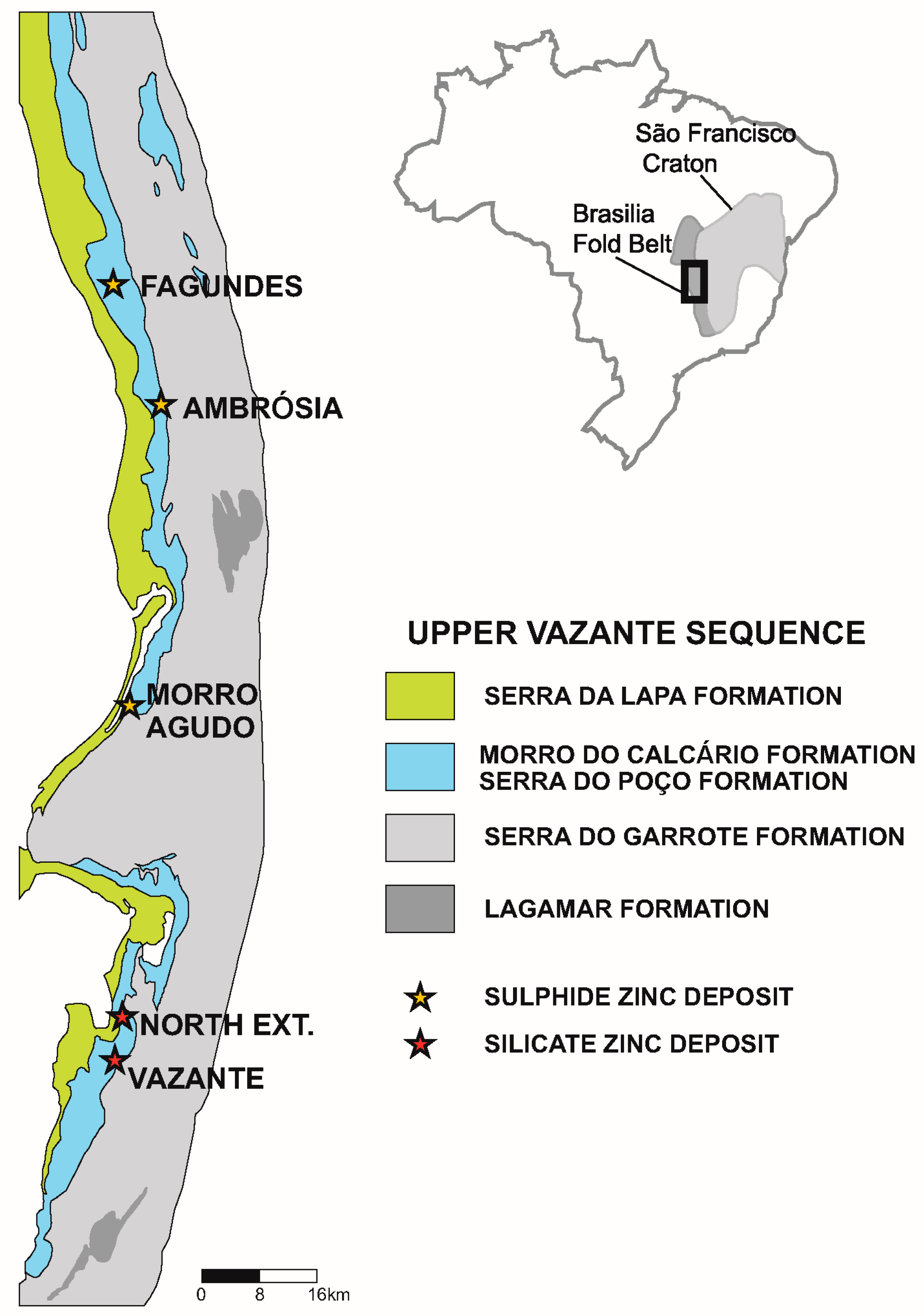
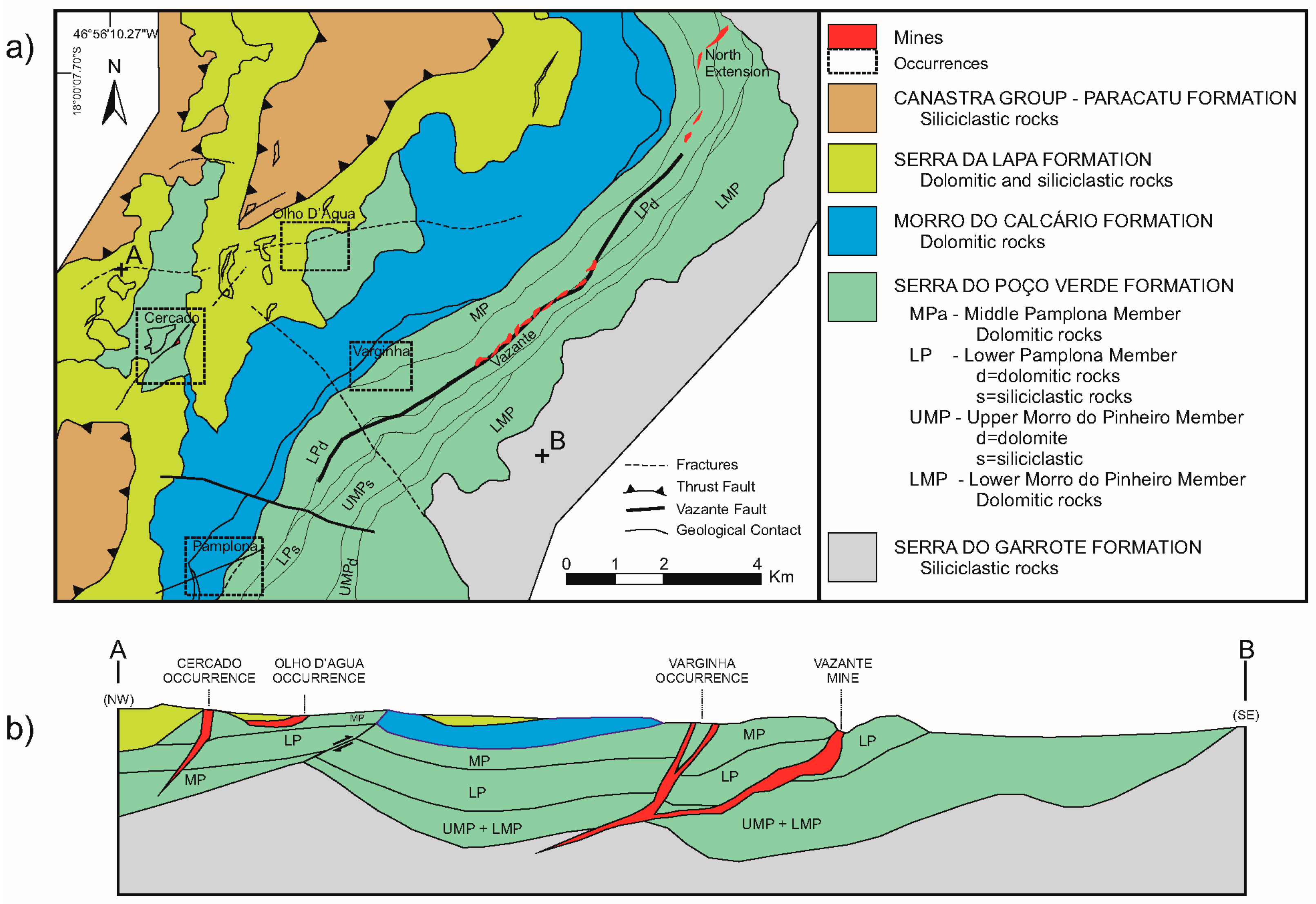

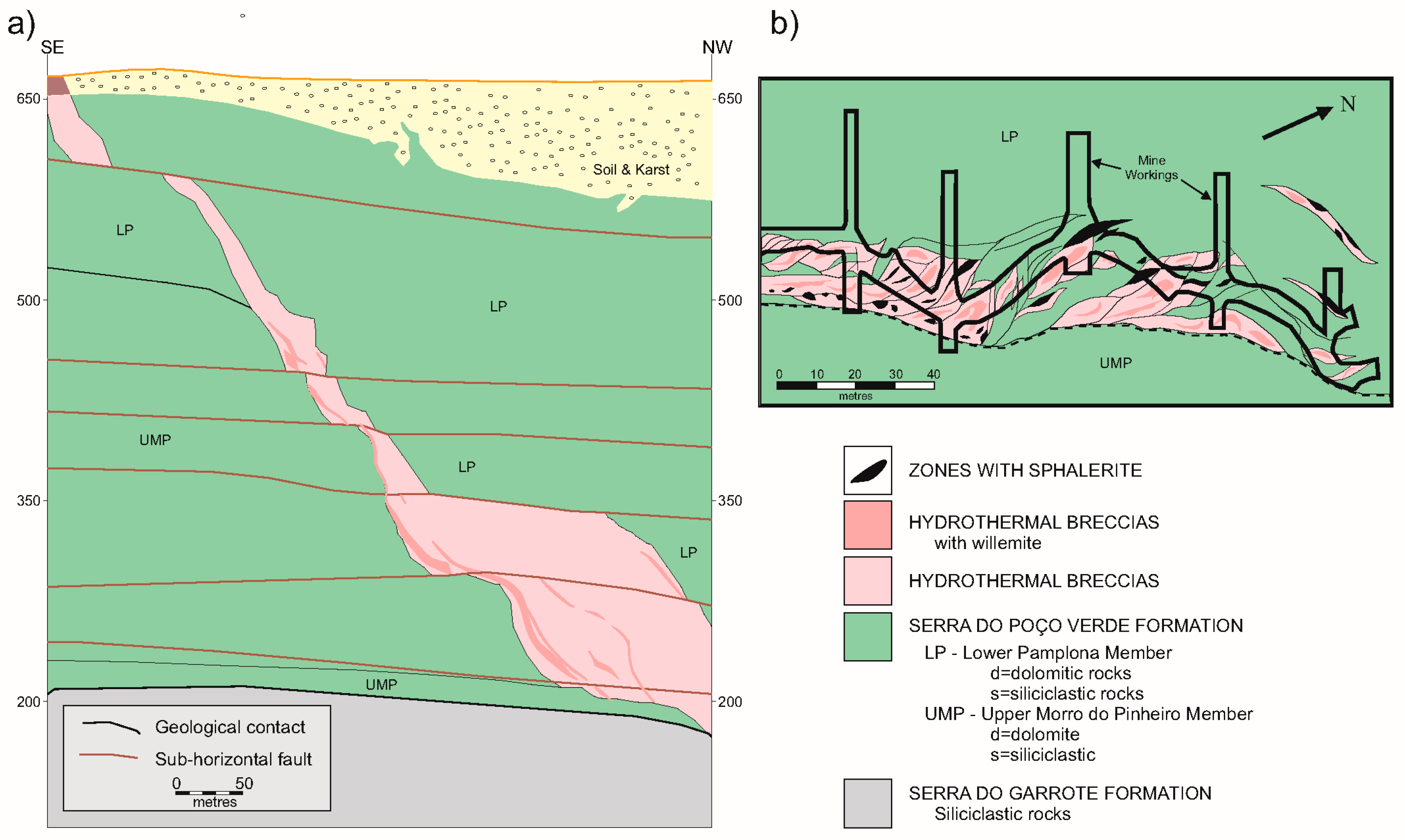
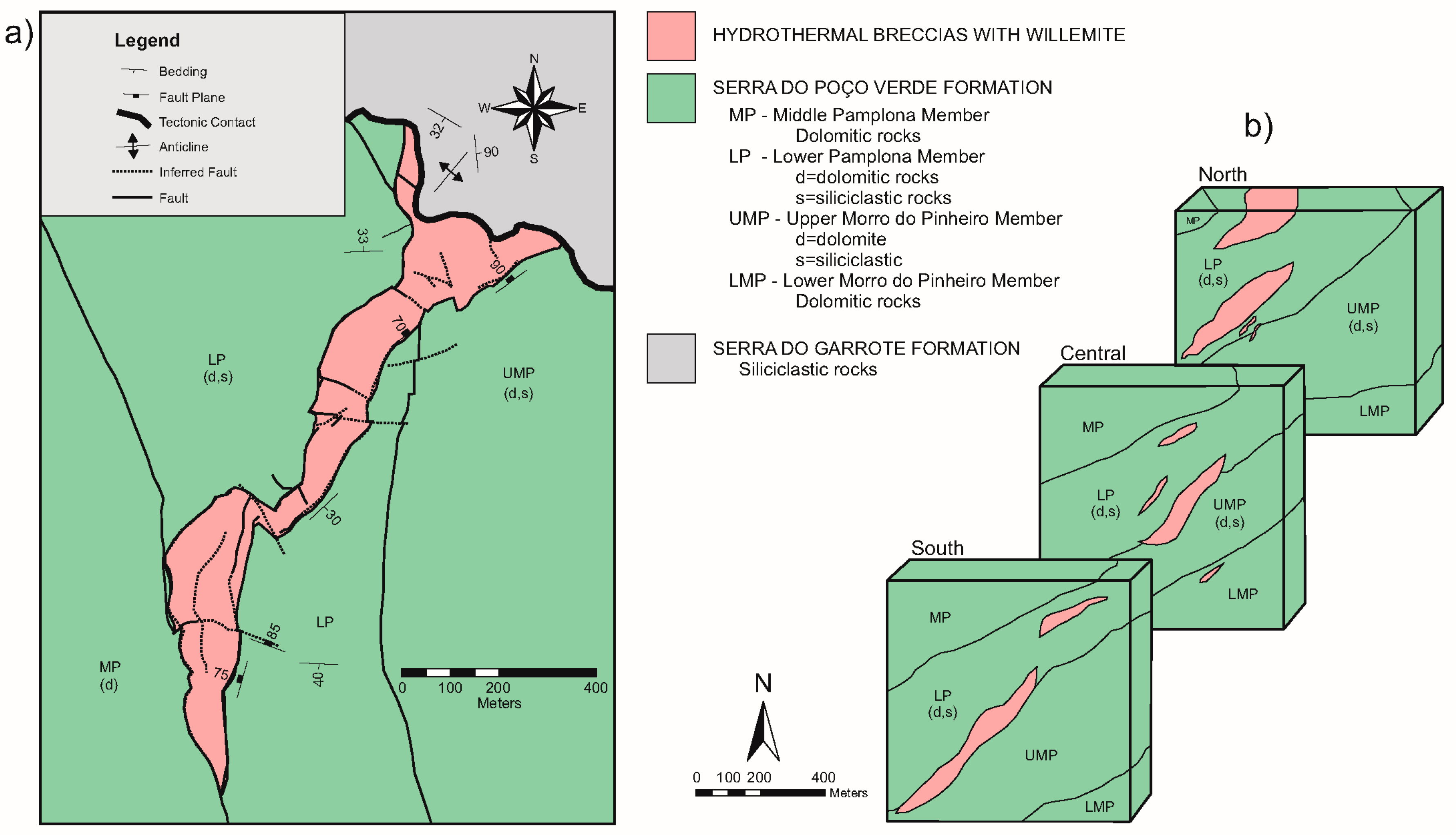
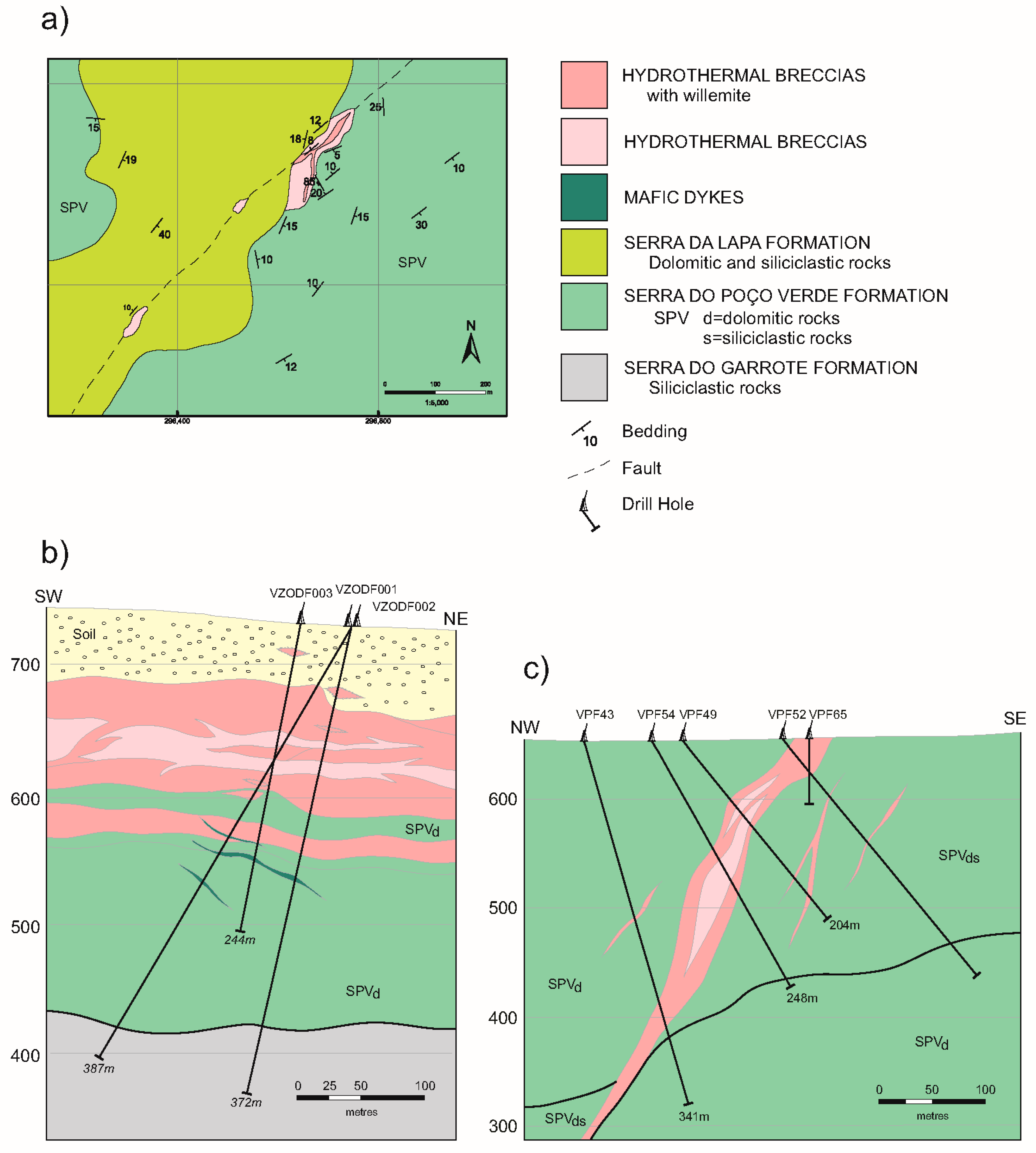

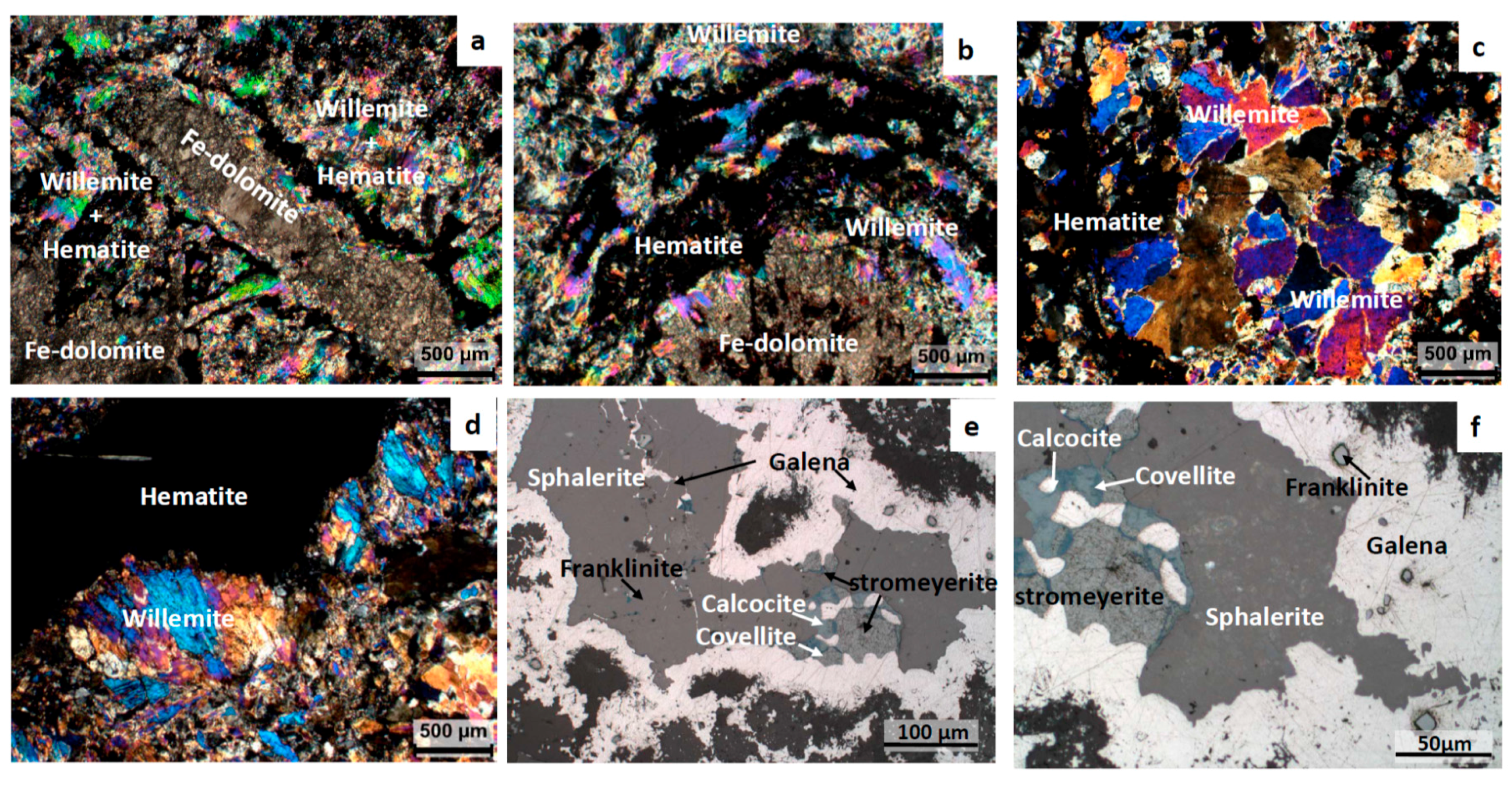
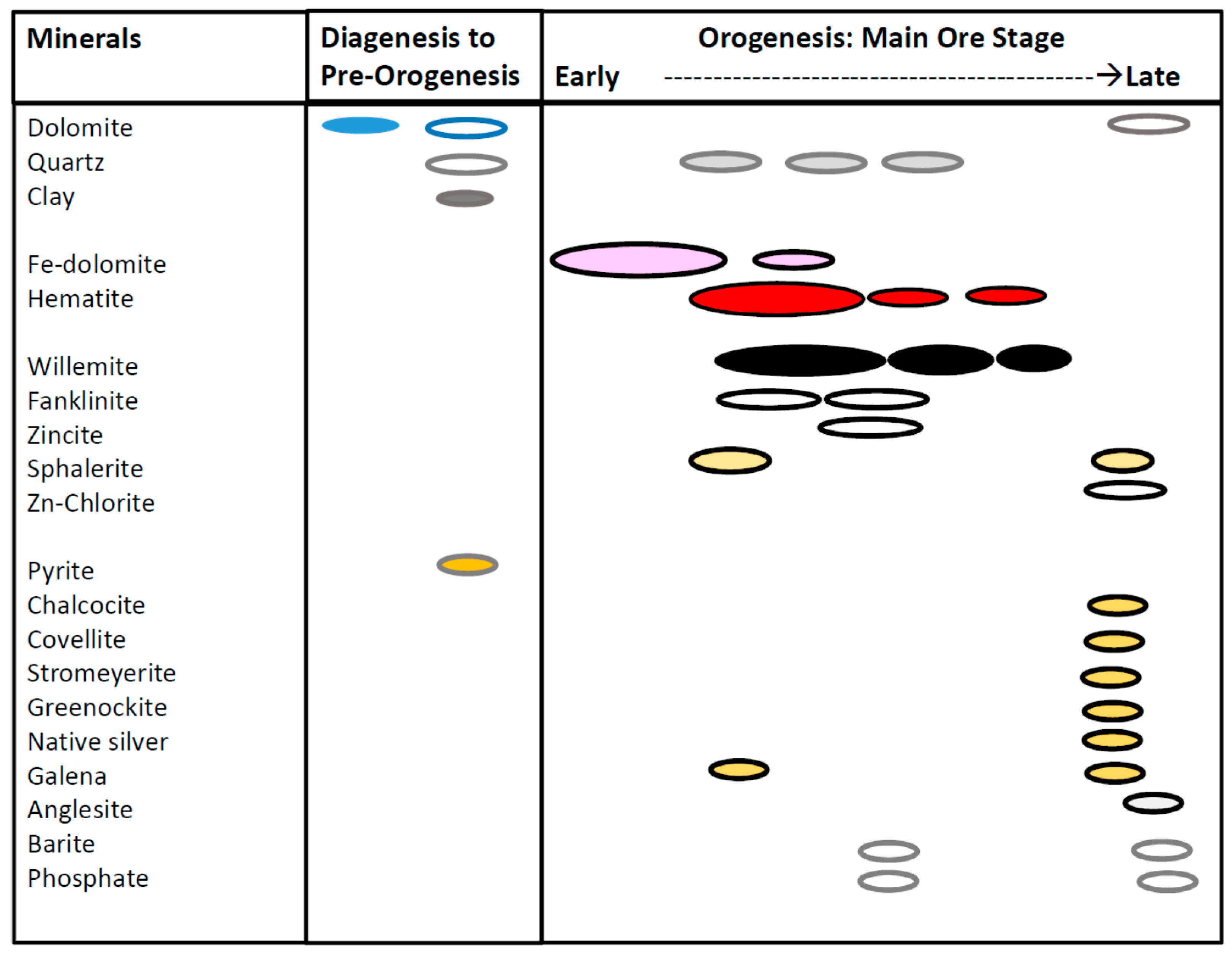
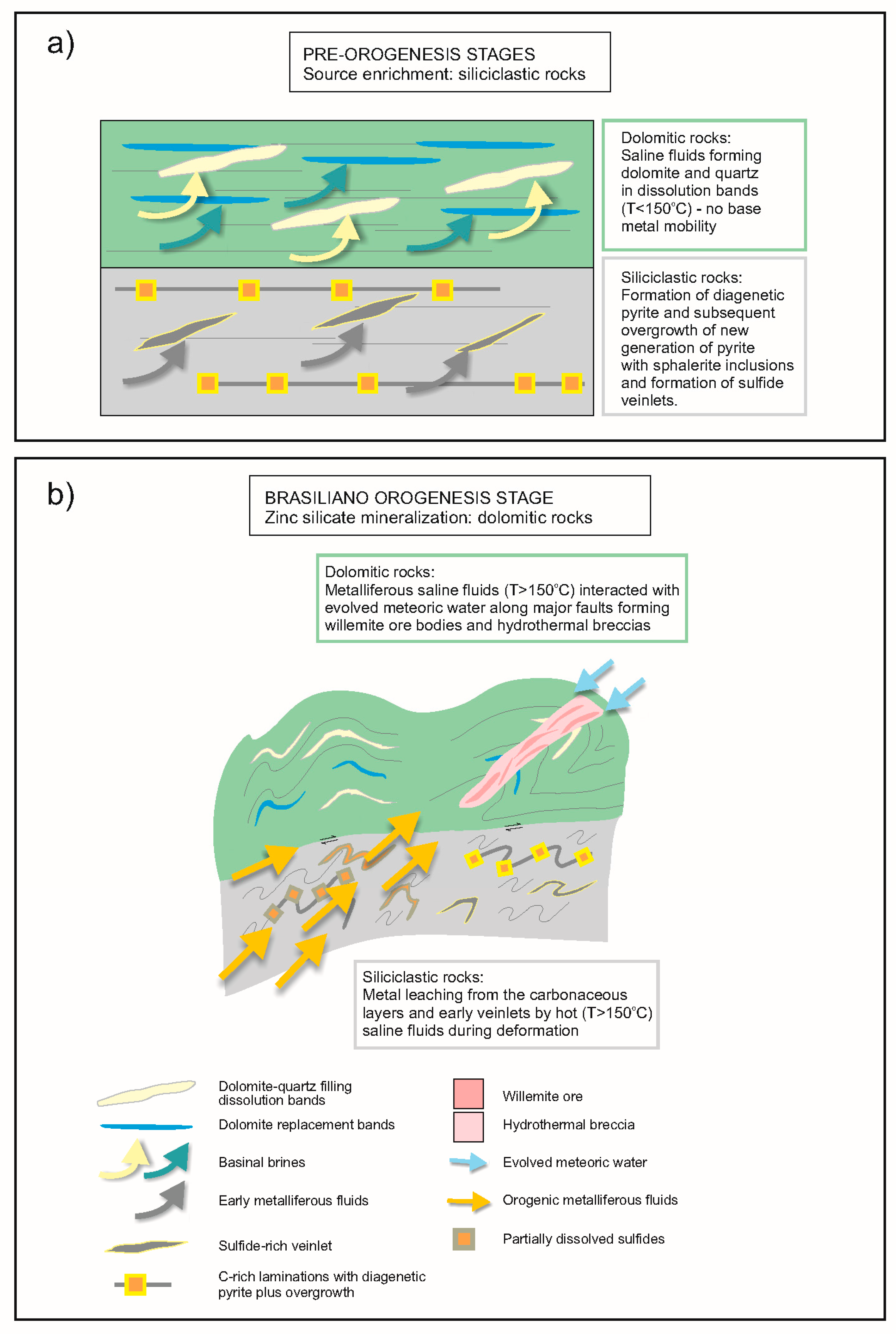
© 2018 by the authors. Licensee MDPI, Basel, Switzerland. This article is an open access article distributed under the terms and conditions of the Creative Commons Attribution (CC BY) license (http://creativecommons.org/licenses/by/4.0/).
Share and Cite
Olivo, G.R.; Monteiro, L.V.S.; Baia, F.; Slezak, P.; Carvalho, I.; Fernandes, N.A.; Oliveira, G.D.; Botura Neto, B.; McGladrey, A.; Silva, A.M.; et al. The Proterozoic Vazante Hypogene Zinc Silicate District, Minas Gerais, Brazil: A Review of the Ore System Applied to Mineral Exploration. Minerals 2018, 8, 22. https://doi.org/10.3390/min8010022
Olivo GR, Monteiro LVS, Baia F, Slezak P, Carvalho I, Fernandes NA, Oliveira GD, Botura Neto B, McGladrey A, Silva AM, et al. The Proterozoic Vazante Hypogene Zinc Silicate District, Minas Gerais, Brazil: A Review of the Ore System Applied to Mineral Exploration. Minerals. 2018; 8(1):22. https://doi.org/10.3390/min8010022
Chicago/Turabian StyleOlivo, Gema R., Lena V. S. Monteiro, Fernando Baia, Paul Slezak, Igor Carvalho, Neil A. Fernandes, Gustavo D. Oliveira, Basilio Botura Neto, Alexandra McGladrey, Adalene M. Silva, and et al. 2018. "The Proterozoic Vazante Hypogene Zinc Silicate District, Minas Gerais, Brazil: A Review of the Ore System Applied to Mineral Exploration" Minerals 8, no. 1: 22. https://doi.org/10.3390/min8010022





